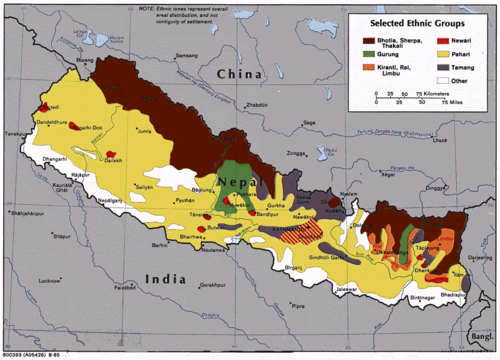Tamang language
Tamang or Moormi (Devanagari: तामाङ; tāmāṅ) is a term used to collectively refer to a dialect cluster spoken mainly in Nepal, Tibet, Sikkim, West Bengal (Mainly Darjeeling Districts - पश्चिम बङ्गाल राज्यको दार्जीलिङ जिल्लाको बिभिन्न भूभाग), some parts of Assam and North East Region. It comprises northern tibetan Tamang, Northwestern Tamang, Southwestern Tamang, Eastern Tamang, and Western Tamang. Lexical similarity between Eastern Tamang (which is regarded as the most prominent) and other Tamang languages varies between 81% to 63%. For comparison, lexical similarity between Spanish and Portuguese, is estimated at 89%.[3]
| Tamang | |
|---|---|
| तामाङ, རྟ་དམག་ / རྟ་མང་/मुर्मि | |
| Native to | Nepal India Bhutan Tibet |
| Ethnicity | Tamang/Moormi |
Native speakers | 1.35 million in Nepal (2011 census)[1] 20,154 in India (2011 census)[2] |
Sino-Tibetan
| |
| Devanagari | |
| Official status | |
Official language in |
|
| Language codes | |
| ISO 639-3 | Variously:taj – Eastern Tamangtdg – Western Tamangtmk – Northwestern Tamang (not distinct)tge – Eastern Gorkha Tamang |
| Glottolog | nucl1729 |
Dialects
Ethnologue divides Tamang into the following varieties due to mutual unintelligibility.
- Eastern Tamang: 759,000 in Nepal (2000 WCD). Population total all countries: 773,000. Sub-dialects are as follows.
- Outer-Eastern Tamang (Sailung Tamang)
- Central-Eastern Tamang (Temal Tamang)
- Southwestern Tamang (Kath-Bhotiya, Lama Bhote, Murmi, Rongba, Sain, Tamang Gyoi, Tamang Gyot, Tamang Lengmo, Tamang Tam)
- Western Tamang: 323,000 (2000 WCD). Sub-dialects are as follows.
- Trisuli (Nuwakot)
- Rasuwa
- Northwestern dialect of Western Tamang (Dhading) — separate ISO code. Population 55,000 (1991 census). Spoken in the central mountainous strip of Nuwakot District, Bagmati Pradesh.
- Southwestern dialect of Western Tamang
- Eastern Gorkha Tamang: 4,000 (2000 WCD). Sub-dialects are as follows.
- Kasigaon
- Kerounja
The Tamang language is the most widely spoken Sino-Tibetan language in Nepal.
Geographical distribution
Ethnologue gives the following location information for the varieties of Tamang.
Eastern Tamang
- Bagmati Pradesh: Bhaktapur District, Chitwan District, Dolkha District, Kathmandu District, Kavrepalanchok District, Lalitpur District, Makwanpur District, eastern Nuwakot District, Ramechhap District, Sindhuli District and western Sindhupalchowk District
- Province No. 1: Okhaldhunga District, western Khotang District, and Udayapur District
Southwestern Tamang
- Bagmati Pradesh: Chitwan District, southern Dhading District, western and northwestern Kathmandu District area and northwestern Makwanpur District
- Province No. 2: Bara District, Parsa District and Rautahat District
Western Tamang
- Bagmati Pradesh: western Nuwakot District, Rasuwa District, and Dhading District
- central mountainous strip of Nuwakot District, Bagmati Pradesh (Northwestern Tamang)
- northeastern Sindhupalchok District, Bagmati Pradesh: Bhote Namlan, and Bhote Chaur, on Trishuli river west bank toward Budhi Gandaki river
- northwestern Makwanpur District, Bagmati Pradesh: Phakel, Chakhel, Khulekhani, Markhu, Tistung, and Palung
- northern Kathmandu District, Bagmati Pradesh: Jhor, Thoka, and Gagal Phedi
Eastern Tamang
- south and east of Jagat, northern Gorkha District, Gandaki Pradesh
Grammar
Some grammatical features of the Tamang languages include:
- A canonical word order of SOV
- Use of postpositions;
- The genitives follow nouns;
- question word medial;
- It is an ergative–absolutive language;
- CV, CVC, CCV, V, CCVC;
Phonetically Tamang languages are tonal.
Phonology
Consonants
| Labial | Dental/ Alveolar |
Retroflex | Palatal | Velar | Glottal | ||
|---|---|---|---|---|---|---|---|
| Stop | voiceless | p | t | ʈ | k | ||
| aspirated | pʰ | tʰ | ʈʰ | kʰ | |||
| palatalized | pʲ | tʲ | ʈʲ | kʲ | |||
| labialized | pʷ | tʷ | ʈʷ | kʷ | |||
| Affricate | voiceless | ts | |||||
| aspirated | tsʰ | ||||||
| palatalized | tsʲ | ||||||
| labialized | tsʷ | ||||||
| Fricative | s | h | |||||
| Nasal | m | n | ŋ | ||||
| Rhotic | r | ||||||
| Approximant | w | l | j | ||||
Vowels
| Front | Back | |
|---|---|---|
| Close | i iː | u uː |
| Mid | e eː | o oː |
| Open | a aː | |
Nasality only marginally occurs, and is typically transcribed with a [ã] mark.
Tones
Four tones occur as high falling [â], mid-high level [á], mid-low level [à], very low [ȁ].[4]
Writing system
Tamangic languages use Tam-Yig. In many situations, however, Tamang is written in Devanāgarī proper.
See also
- Tamang (ethnic group)
- Gurung (ethnic group)
- Languages of Nepal
- Languages of Bhutan
References
- Eastern Tamang at Ethnologue (18th ed., 2015)
Western Tamang at Ethnologue (18th ed., 2015)
Northwestern Tamang (not distinct) at Ethnologue (18th ed., 2015)
Eastern Gorkha Tamang at Ethnologue (18th ed., 2015) - "Statement 1: Abstract of speakers' strength of languages and mother tongues - 2011". www.censusindia.gov.in. Office of the Registrar General & Census Commissioner, India. Retrieved 7 July 2018.
- Ethnologue report for Spanish
- Mazaudon (2003)
- Perumal Samy P. (2013). Tamang in LSI Sikkim, volume I Page Nos. 404-472. Published by Office of the Registrar General & Census Commissioner,India, Ministry of Home Affairs, Government of India.
- Hwang, Hyunkyung; Lee, Seunghun J.; P. Gerber; S. Grollmann (2019). "Laryngeal contrast and tone in Tamang: an analysis based on a new set of Tamang data". Journal of the Phonetic Society of Japan (23.1): 41–50. doi:10.24467/onseikenkyu.23.0_41.
External links
| Tamang language test of Wikipedia at Wikimedia Incubator |
- Counting in Tamang
- ELAR archive of Tamang
